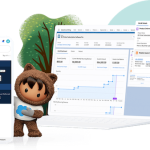This article was written in partnership with Sushil Panta, Senior Director of Salesforce Business Value Services.
Are you taking a hard look at your budgets? You wouldn’t be alone. With all the talk about economic headwinds, many companies are pausing new programs, focusing only on what is essential to keep the business afloat. But there’s a better way to navigate economic uncertainty: find ways to become more efficient, like automation, and invest in them smartly.
Even when you’re understandably cautious about spending overall, investing in the right technology can actually save time and money in the short term. That’s even more true over the longer term, because whatever the future holds, you can bet digital transformation will be key to navigating it successfully.
One thing we know is that every recession is followed by an expansion. The latter often lasts much longer than the former, as was the case after World War II, the dot-com bubble, and the Great Recession. The trick, then, is not to run away from all new investments, but to run toward the right ones.
But how do you know which are the right investments? The answer is simple: The right investments create the greatest benefits at the lowest relative cost, while maximising speed for success now.
I’ll explain each of those components below and give your business a better framework through which to make some of your most important spending decisions.
How do you measure the benefits of your tech investments?
The best way to define the benefits of any investment is through the eyes of your customer. Be clear on the pain points you need to address and the outcomes you seek to reduce complexity for them.
Using your current processes and performance metrics as a baseline, and by making a reasonable estimate about your future improvements as a result of new technology, you can then estimate quantifiable benefits. These could include incremental revenue growth and hard-to-quantify but highly strategic benefits such as employee engagement.
Let’s explore these sources of benefits in more detail:
Grow revenue through current and new streams
Revenue growth is not just about selling more of the same products to the same customers. It is increasingly about activating new revenue streams that might be more predictable and profitable, acquiring new customers, and entering new markets. However, you need to know when to send what offers to whom to maximise conversion. Technology can help with that.
For example, you don’t want to send a marketing offer for a new product when the customer hasn’t heard from your service department on a pre-existing issue, or to a customer who may be behind on an invoice payment. On the other hand, good application of digital technologies such as artificial intelligence (AI) and machine learning can help uncover a customer’s changing buying patterns or identify “at-risk” customers.
Simplify + streamline + automate = more efficiency
Efficiency gains are about simplifying and streamlining complex processes, automating manual tasks, and removing redundancies. The average enterprise uses a whopping 976 applications. Vendor and system sprawl, often the result of adopting point solutions to fill immediate needs department by department, create far greater inefficiencies down the road. Vendor consolidation is one important way in which companies can reduce these complexities, both for their IT infrastructure and their bottom line.
Here’s an example of what that can look like: RBC Wealth Management, a division of RBC Capital Markets, LLC, is a values-driven financial institution providing clients with customized strategies to grow, preserve, and share their wealth. By consolidating 26 systems into one, RBC Wealth Management reduced maintenance costs by 50%, while continuing to deliver on client and advisor expectations.
Create better productivity pathways
Productivity gains are about getting more outputs for the same inputs or the same output for less inputs. In today’s constrained supply chain and volatile labour market, the need for improving your forecasting, supply chain planning, and employee engagement has never been greater. These are all areas that the right technology, combined with the right strategy, people, and processes, can improve. The right technology allows you to do more with the data you have, driving productivity and better results with intelligence and automation.
So what does a productivity benefit look like?
Take ADT, for instance, a leader in home and commercial security that strives to deliver safe, smart, and sustainable security solutions. ADT leverages automation and intelligence to drive cost savings, deliver faster customer support, and increase agent productivity. In fact, ADT has been able to move 40% of service appointments to virtual.
Remember, your goal is to maximise ROI
New revenues? Increased efficiencies? Productivity gains? They all sound great, but what will that cost? Of course we all want to keep costs low, but it’s important to remember the overall goal is not to minimise investment per se, but rather to maximise return on investment (ROI).
Take it from Schneider Electric. The global leader in energy management and automation is transforming the way the world uses energy. Schneider Electric drives efficiency across the company — enabling its sales reps to close deals 30% faster and save $2.7 million in IT costs over a three-year period.
Or consider the path taken by GE Appliances. With Service Cloud, the company’s agents have a single source of truth to clearly see where customers are in their ownership journey. Plus, the company can handle more calls at less cost by pairing Service Cloud Voice with partner telephony from Amazon Connect, increasing first-call resolution and decreasing handle times by up to 12%.
“The return on investment for the technology we’ve employed is really agent efficiency and the ability to connect with the owner and create that human experience,” said Angie Corbett, senior manager of ecommerce sales and digital engagement. “That’s priceless.”
We see the right technology will deliver the greatest benefit at the lowest relative cost. That being said, maximising your benefit at a manageable cost is essential. Here are some best practices:
- Select a cloud-first CRM strategy, which is supported by the fact that more software spending is moving to the cloud. With a cloud-first approach, you can manage costs more effectively through lower maintenance costs, a pay-as-you-go model, improved security, and better enablement of a mobile workforce.
- Pick a single, integrated CRM platform rather than a patchwork of expansive point solutions that require a great deal of custom integration. Those patchwork solutions not only cost a lot of time during setup but are also hard to maintain, brittle, and less scalable. A platform mindset supports building integrated, end-to-end customer journeys, which is essential to close the divide between many enterprise IT platforms and their customer expectations.
- Pick pre-built industry solutions, which will help you accelerate time to value and reduce implementation costs, by introducing industry-specific objects, real-time data insights, workflows, and analytics, all out of the box, thus minimising the need for custom developments.
The value of maximum speed for success now
Speed is about how quickly you can go from buying a product to using it to drive business outcomes.
For your CFO, it might mean the payback period. For your IT executive, it might mean the time between the implementation planning and phase 1 rollout. For your customers, it might mean the ease of doing business with you anytime, anywhere, and through any channel. Whatever your success measurement system, speed is integral to achieving it – now more than ever. Speed gives you adaptability, and adaptability gives you the power to not only survive but thrive.
Ideally, you end up with the kind of impact seen by SmartRent, a leading smart home solutions provider that focuses on driving automation and efficiency for its customers. SmartRent leverages automation capabilities to eliminate manual tasks and streamline processes, increasing employee retention by 92% and saving employees 120 hours in onboarding time. Speed-to-impact is essential for getting employees onboarded to deliver customer value quickly.
It is possible to cut costs and reduce complexity while creating resilience within your company. You can do this without compromise by consolidating systems and investing in the right technology for your business. With automation, intelligence, consolidation, and self-service, you can maximise value and create customers for life.

























